So you have a new business. You know you need SEO, but you don’t know where to start.
Don’t worry, you’re not alone.
Developing an SEO content strategy can seem like a daunting task best left to the experts. But once you look a little bit closer at SEO to see how it works, it’s really not that hard.
To help you cut through the clutter and better understand how SEO works, I created a visual called the SEO Spider’s Web.
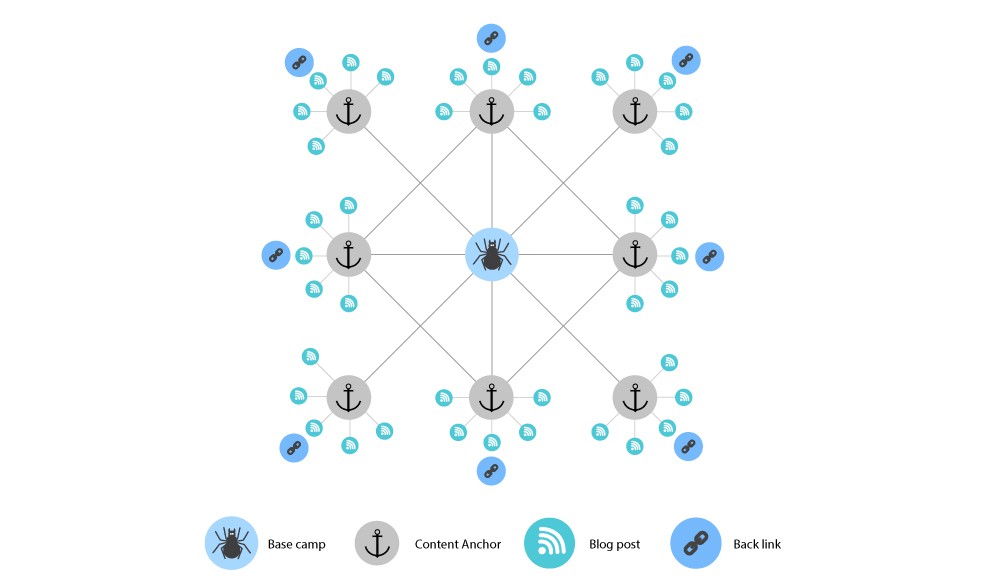
A spider web looks like a complex creation from afar, but if you take a closer look, you can see all the simple steps the spider took to create it. Creating anchor points and slowly weaving silk between these points to strengthen the web. This is similar to the way the best content marketers approach SEO.
The anchor points are the very best pieces of content on your website, the pieces of silk are the hyperlinks that connect them, and the rest of the web structure is the other content on your site that supports these key anchor points -- your blog posts.
So how do you create your very own SEO Spider’s Web?
Here are 4 steps you can take to get the appropriate structures in place and start seeing results from your SEO efforts.
Step 1: Find content opportunities
To kick things off, you are looking for what are called “content opportunities” that you can build your anchor points for. These opportunities are essentially keyword search terms that you want to be known for, and are likely to rank for if you optimize them correctly.
It’s unlikely you will target a broad keyword term such as “content marketing,” for example. Instead, you’ll target a variety of long tail keywords.
Long tail keywords are more specific phrases about all sorts of things in your niche, such as:
- Content marketing for small businesses
- Content marketing strategy examples
- Content marketing editorial calendar
There are three main things that make a keyword term an “opportunity” to go after:
- It has high search volume
- The other content ranking for the term is outdated or underdone
- The other content ranking has a lot of social media engagement
Target high search volume keywords
There are a lot of tools to help you find long tail keywords. For example, Keyword Planner is a free AdWords tool you can use, though it is oriented towards keywords for paid ads.
To start, try typing your target keyword into Google. Then, scroll to the bottom of search results and see the “searches related to” section:
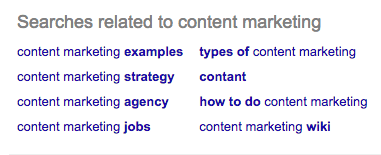
I also recommend using a long tail keyword suggestion tool like Keywordtool.io. It not only gives keyword suggestions but will show you detailed information about each keyword’s search volume over time:
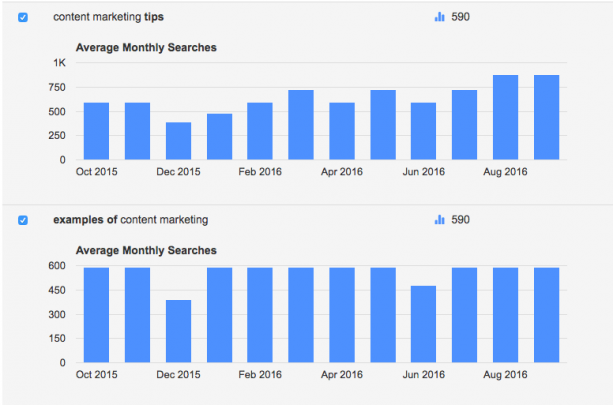
You’ll want to target keywords that have a fairly high and consistent search volume.
Look for underdone or outdated content
Google likes to deliver the most accurate, up-to-date results in search. So if a topic related to your niche has been covered but not recently, that could be an opportunity to rank well in search.
Type one of your target keywords into Google (e.g. examples of content marketing). On the first page of results, most of the listings should have a publish date alongside them:
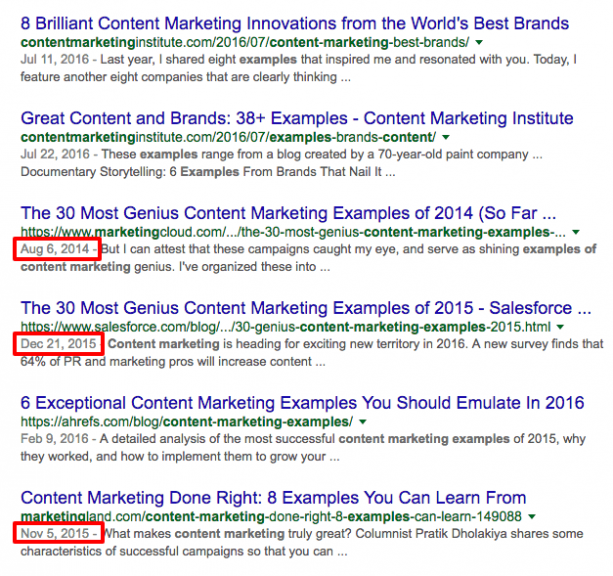
Some are fresh, but others are a year or more old. These are your content opportunities.
Whatever content you do decide to create, just make sure it’s better than the original. Then you’ll make Google happy twofold for:
- Content freshness
- Content quality
See those two high-ranking posts covering 30 genius content marketing examples? You could create a piece of content that covers 50, for example.
If you take a look at Google’s Search Quality Rater’s Guidelines you’ll see for yourself -- Google cares a lot about quality, comprehensive content. So look for underdone content that you can improve upon.
Look for topics that resonate
You want to create content that helps you broaden your brand reach, not just in search results. So you should also pay attention to what topics and content types people like the most.
Creating content that resonates can help you get a lot of social shares and more backlinks in the process.
To find these opportunities, I recommend heading over to Buzzsumo and typing in your keyword.

The tool will return the most popular pieces of content related to your keyword, sorted by total shares across Facebook, LinkedIn, Twitter, and other platforms:

When you find a topic you like, you can click the “View Backlinks” button to see if the content is getting a lot of links as well:

Building backlinks from your content matters a lot for SEO -- Google uses backlinks to determine your domain authority. It’s one of their top 3 rank factors.
Step 2: Create high-performing content anchors
Now that you have some keyword opportunities to target, it’s time to create your content anchors. Anchor content is a super high quality, long form piece that will help your brand stand out from the rest.
Think along the lines of ultimate guides and top 100 list posts. Besides being comprehensive and awesome, make sure your anchor content:
- Stands out from the crowd: You’ll see a lot of instances of people just copying the headline of popular articles in hopes of better rankings:
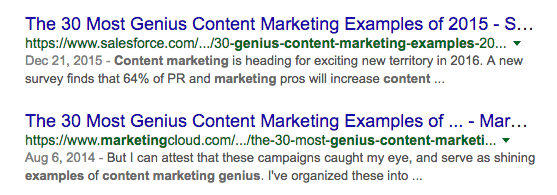
But I don’t recommend using this strategy. Instead, develop a title that’s unique and draws interest in its own right.
There are a lot of great tools out there that will help you come up with headlines and improve them.
- Is formatted for readability: Your anchor content should be 2000+ words, but make sure you break it up into easily readable chunks for your audience. Use subheadings (H2, H3), short paragraphs, and bullet points to increase white space. You should also highlight key points for readers who like to scan.
- Has visuals and evidence to back it up: Did you know content with colored visuals increases people's willingness to read a piece of content by 80%? Visuals are also a great way to break up text, illustrate your point, and improve readability. You should also use statistics, data and expert sources to backup important points you make.
- Is Optimized for on-page SEO: Your target keyword should appear naturally throughout your body text, but don’t forget about other on-page SEO factors. Try to use your keyword in the:
- Title tag
- URL
- H1 tags
- Anchor text
- Image file names
- Image alt text
Here’s a helpful infographic from Backlinko about on-page SEO best practices.
Step 3: Boost the visibility of that content
Once you start creating content, you need to develop a “basecamp” for your website. This is a page that helps site visitors easily navigate to the most important content on your website.
If you think of it terms of the SEO Spider’s Web, the basecamp is the place in the middle where your spider sits.
And yes, you guessed it -- site structure affects SEO.
If you need help putting together your basecamp, check out my “Start Here” page on Blogger Sidekick. Here I explain what Blogger Sidekick is all about, and help readers navigate to popular blog posts, free resources, and other content:
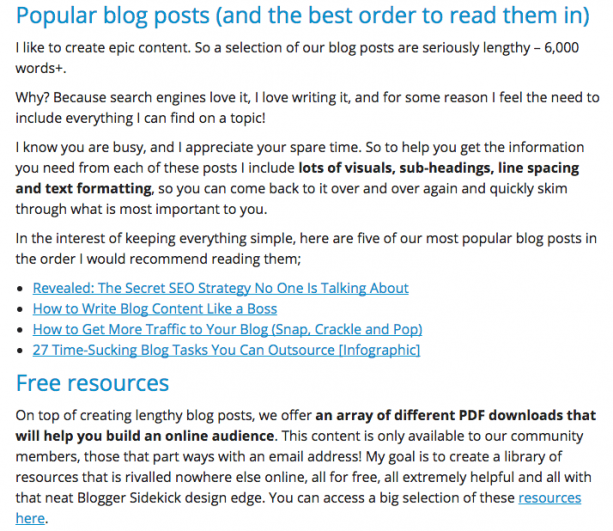
You can also create connections between different blog posts by recommending related content on this page, and any other relevant pages on your site.

Step 4: Promote, promote, promote
In some ways, the SEO Spider’s Web seems tricky. The spider builds a beautiful, intricate web, but whether it catches juicy flies or debris is really up to the world around it.
Just like the spider’s web, the world around your site will affect your SEO. But luckily you have some control over this as long as you promote your content.
So how can you draw engagement and traffic (juicy flies) to your SEO spider’s web? Here are some suggestions:
Social media outreach
Beyond just sharing your content on social media, actively reach out to social influencers to share your content.
Using Buzzsumo, search by keyword and find people who share content similar to yours.

Then you can @mention them or send them an email asking to share.
Community engagement
Get on Q&A sites, niche forms and other discussion platforms. Join the conversation and suggest your content as a resource when appropriate. The possibilities are endless if you target Facebook and LinkedIn groups as well.
Guest blogging
Guest blogging will help you build links and broaden your brand’s reach at the same time. Use Google to search for guest blogging opportunities in your niche using keywords like:
- [Niche keyword] + “guest post submission”
- [Niche keyword] + “write for us”
- [Niche keyword] + “contribution guidelines”
Targeted link building
Look for other opportunities to build links, such as suggesting your content to a roundup post or targeting pages with broken links.
To find broken links, look for resource pages (use the search command “[Niche keyword] intitle:resources”), then use a tool such as Domain Hunter Plus to analyze the links on the page.
If you find any outdated or broken links, reach out to the webmaster and recommend your content as a replacement.
Paid media
Paid media isn’t just for product ads anymore. You can now use it to promote your blog content.
Use a tool like Outbrain or Taboola, and promote your posts to appear as “suggested content” on sites throughout the web.
Facebook, Twitter, LinkedIn and other social platforms also offer paid options to improve your content’s reach. They’re customizable, affordable, and allow you to target very specific audiences based on demographics, location, interests, and more.
Wrapping Up
Creating an SEO content strategy for a new business can seem like a daunting task. But by taking it step-by-step, any brand can increase their reach and bring in business with the help of blogging. Here’s a recap:
Step 1: Find content opportunities
- Target high search volume keywords
- Look for underdone or outdated content
- Look for topics that resonate
Step 2: Create high-performing content anchors
- Stand out from the crowd
- Format for readability
- Use visuals and evidence
- Optimize for on-page SEO
Step 3: Boost content visibility
- Create a basecamp
- Cross-link between content
Step 4: Promote, promote, promote
- Social media outreach
- Community engagement
- Guest blogging
- Targeted link building
- Paid media







on
Such an informative blog
SEO content writing services having number of benefits. Like it generate the unique and quality content with your focus keyword.
on
Thanks a lot for sharing such a great article. I really enjoyed reading this article as it provides me with many informative things. I Like it. Keep it up….
on
Amazing article! Thanks so much for posting this article. Your posts is really helpful for me.Thanks for your wonderful post.
on
Thank you so much for your wonderful info about how to create seo content strategy in new business and i find it excellently helpful.
on
Great tips for the content all the SEO’s should refer! A superb article. Keep sharing such useful articles.
on
Good job! I Like this tips Will
on
This article is marvelous. I really enjoyed reading this article as it provides me many informative things.
Thanks for sharing this great article.
on
Defining that personality takes time but it’s something you have to really focus on and hone as you go. People like personality, humor, and attitude. You are not a robot. You have a style and voice of your own so let that shine through!